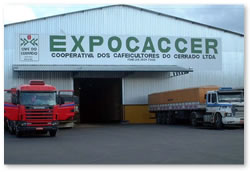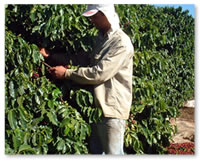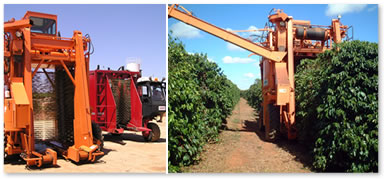|
|
 |
In the shade |
I cry picking coffee, thinking about the migrant that fled. |
| |
This is a translation for a haiku which was written by Shuhei Uetsuka, who is a leader of the Japanese immigrants to Brazil, hoping freedom to the new world.
In 1909, the ship Kasado-Maru arrived at the port of Santos, carrying 781 Japanese immigrants with a great hope and dream. They were first put into the Hospedaria de Imigrantes and settled in farms behind there. And there was no utopia but awefully hard works. They decided to immigrate over here because the cultivation was described to them as "planting the tree that provides gold" and wanted to escape from their harsh work in notrh Japan. However, there were further hardships - different climate and culture, endemic diseases, immigration act against them, and a war. They had only to trust themselves each other to live.
This haiku was naturally created in such harsh days they had to be patient only for living. |
| |
Recent years, the second or third generation of the Japanese Brazilian have played important rules in various fields as well as coffee business and been highly evaluated as people of merit.
It was my long-cherished dream to visit the top of coffee world Brazil, as both Japanese and a coffee man. We are playing a video of the inspection in Brazil in our store, but here I'd like to tell you all who cannot come watch it. |
|

With Mr.Paulo in the farm Botanica. |
|
| |
In Brazilian coffee cultivation, they had traditionally put more importance on quantity than quality, and most coffee had lacked in characteristic. Therefore, it was not rare that they have abundantly used those standard coffee like Brazil Santos for exporting or blending with others. Recently, howver, this tendency has changed and they have developed a brand-new high quality coffee, which is totally different from the conventional ones: Cerrado Coffee from Minas Gerais. |
| |
What is Cerrado Coffee? |
| |
There is a plateau called cerrado, which is spreading in middle-east Minas Gerais and five times as large as Japan in size (left figure)
The coffee is famous for its high-quality, and the cultivation area is spreading 200km from north to south, east to west. Of cause, there some reasons for its high-quality evaluation: |
| |
| 1.Farm above the Clouds |
The average altitude of the plateau is about 1000m above the sea. Mr.Paulo says they have clouds under his farm in rainy days. As a result, there is a great diurnal temperature range, which provides best environment for making perfect coffee. Moreover, its vast and flat hill let the trees have sunshine uniformly, and provide uniform sized berrys. |
|
|
| 2.Grace of the Sun |
It is located at S.Lat. 17°and pretty close to the equator. Therefore, they have long hours of sunshine and no frost damage. The blessing of the sun helps a lot to produce fine coffee and maintain the production stable. |
|
|
| 3.Grace of Water |
The soil is well drained and the lower layers are porous which has high water holding capacity. As the water veins run at 1200m high above sea level, Botanica farm can manage without irrigation system. Rather, they had sold the water from a caldera there with the name of "Serra Negra". Thus, coffee trees can naturally grow by themselves. |
|
| |
|
|
|
|
| 4.Well-balanced Climate |
| The climate is proper for crop cultivation because of the stable annual precipitation. Especially, they have little rainfall in harvest time and they do not have to worry about fermentation, mold, nor taste change because of rain. |
|
|
| 5.Japanese Agricultural Technique |
| The best part is the ideal condition that their ancestors have created for more than 100 years for coffee production and harvest. They have independently introduced Japanese agricultural technique into coffee cultivation. The way in which they try to well take care of the land and crops has been still followed in the other side of the world. |
|
|
|
|
| |
CACCER |
| |
Even cerrado coffee, its quality differs depending on the farm.
When it comes to ship it as a product, it will be a problem if there is a big difference in producting process among each farm because it influences a lot on the coffee quality and damages the image of cerrado coffee.
So as to prevent it, they have established CACCER (union of 17 producers and 45 farms) for quality improvement and stable supply. It is also the organization which issued a quality certification for the first time.
As mentioned above, cerrado is originally proper for coffee cultivation, but its modern refining method makes it even better. Although it's been still only 20 years since it began, they have been successful in maintaining high quality and yield. Here, I'd like to show you its managing process which has attracted the world's attention. |
|

Expocaccer. The center collection point of harvested coffee. |
|
| |
Growth
Even in cerrado, it's still laborious to take care of all coffee depending on the weather. Although they usually have irrigation equipments in major farms, they were useing big watering machines in those farms of Caccer (all of which are located at relatively lower hight (900m)) as they had not had rain for 2 month when we visited there (right figure).
Introduction of heavy machines is one of the strong points of Caccer, making the most use of its vast and flat land. Although it costs a lot to introduce the drip irrigation system, some of the farms have already gotten it because it allows water to drip slowly to the roots through a network of pipes. |
|
Harvest
There are two ways for harvesting, by hand or by machine.
As for hand-picking, they the berrys off leaves. (left figure)
Although it makes it possible to collect only fully-ripen berrys, it requires much time and a number of labors for harvesting all coffee from the cast land.
In Caccer, they have recommended the farms to introduce a high-performance harvesting machine which can pick up only ripen berrys, and has equivalennt power to 1000 labors. Although it looks just like a rice harvester in Japan, it's almost five times as big. Also, it automatically exchanges variety types of brushes inside so as to change the types and amount of berrys to pick up. |

The self-propelling sprinkler, too long to see its end... |
|

Carefully picking ripen berrys. |

Left:The machine is so high that it's hard to even go up to the driver seat.
Right:It dynamically covers the whole tree for harvesting. |
|
|
| |
|